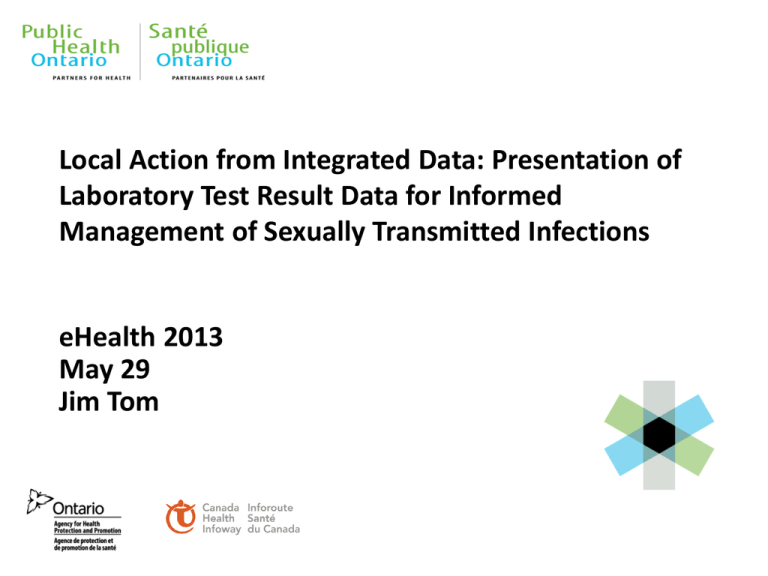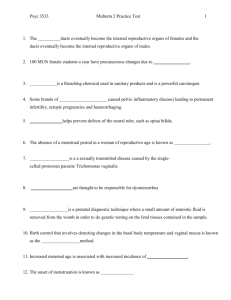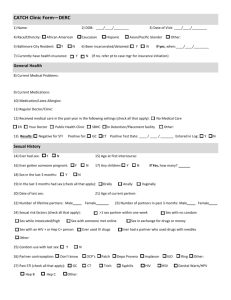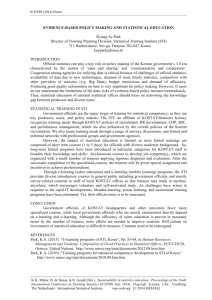PHO Powerpoint Template - title and sample slides - e
advertisement

Local Action from Integrated Data: Presentation of Laboratory Test Result Data for Informed Management of Sexually Transmitted Infections eHealth 2013 May 29 Jim Tom Partnership with Canada Health Infoway 2 Who is Public Health Ontario? • Crown corporation • Dedicated to protection and promotion of health of Ontarians • Wellness of communities and populations • Provides expert scientific and technical support to government, local public health agencies, healthcare • • • • • Communicable & infectious diseases Infection prevention and control Environmental and occupational health Health promotion, chronic disease and injury prevention Public health laboratory services • Surveillance, epidemiology, research, professional development 3 Data-Driven Decision Support in Public Health • Timeliness • Data on other factors such as anti-microbial resistance • Localization • Meaning 4 The Challenge in STI Practices • Current STI data available includes • Reportable diseases database (e.g. iPHIS) • Lacks information about denominator • End users cannot easily compare data to other jurisdictions • Lacks trend of antibiotic susceptibilities • STI laboratory data • Reference laboratory testing data often used for national guideline development (e.g. N. gonorrhoeae resistance patterns) • Aggregated to provincial level • Often 1-2 years delayed 5 Examples of Questions … • There is an increase in the total # of chlamydia diagnoses in my health unit among women aged 15-24. • Does this reflect a change in testing practices? • Are men of this same age group seeing an increase? And in percent positivity? • Are more people being tested for Chlamydia trachomatis? Are more infections detected? Does the percent positivity change as a result? • There are recent reports of increasing antimicrobial resistance of Neisseria gonorrhoeae in Toronto. • What is the rate of resistance in my health unit? • What percentage of infections are diagnosed by culture? How representative is this of the population of the health unit? • Are there certain populations that appear more vulnerable to drug resistant gonorrhea? 6 STI Laboratory Data Tool: Project Objectives • To provide STI laboratory data to Boards of Health and MOHLTC • Use Public Health Ontario laboratory STI test data • Neisseria gonorrhoeae • Chlamydia trachomatis • Web-based platform and visualization tool • • • • • Data refreshed once a month Aggregated by health unit Denominators (# samples submitted) Resistance data Supplementary tools and information • Inform decisions about • Whom to test • Which infections to test for • Which antibiotics to use, before individual results available 7 High Level Architecture “Online Services Delivery” Platform User interface Analytic tools No personally identifiable info Restricted Access Lab Info System Data marts Refresh process Analytic database 8 Organization of Data Queries • Six Primary queries • Slicer combinations • Report reference sheets • Ensure data logic 9 Home page of STI laboratory data platform 10 The Six Queries 11 Query #1 12 Query #1 13 Query #1 14 Query #1 15 Query #1 16 Query #1 17 Query #1 18 Other views 19 Public Health Ontario Views of antibiotic susceptibility 20 Public Health Ontario Links to STI Guidelines 21 Tool Instructions 22 Additional Tools 23 STI Publications 24 Report caveats 25 Chronology of Testing Methods 26 Legend 27 Data Quality • Integrated with PHO Laboratory Surveillance Program • Core Initiatives: • Data quality protocols and procedures in development – key infrastructure component for the program • Analysis of laboratory data quality using various tools - How is the data pulled (what do we get?) - How is the data reconciled (what are the gaps, reasons for gaps, validity of data exclusion) - What is needed to “fix” the data - Involve subject matter experts in the review 28 Improving and Integrating Feedback 29 Benefits Evaluation • Assessment of benefits is a critical Infoway requirement • Next step beyond pilot and “go-live” • Anticipated outcomes include: • Short-term: • More informed decisions for heightened screening in regions with high incidence • More informed treatment changes based on localized data about antimicrobial resistance • Long-term: • Potential decrease in burden of STI • More informed decisions on decreased antibiotic resistance in Neisseria gonorrhoeae 30 Comments or Questions? 31











